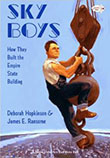Sky Boys: How They Built the Empire State Building Q&A

Use these questions with children 7 to 10 years old to discuss the following economic concepts in Sky Boys: How They Built the Empire State Building: human capital, human resources, productivity, and physical capital.
View all of our Parent Q&A resources.
Teachers: View the lesson plan using Sky Boys: How They Built the Empire State Building.
Book written by Deborah Hopkinson and James E. Ransome (ISBN: 978-0-375-86541-1).
Questions:
1. Human resources are people who do mental and/or physical work to produce goods and services. What are some examples of human resources in the story?
All of the “sky boys” in the story are examples of human resources: the Derrick men (the Heater, the Catcher, the Bucker-up, and the Gunman); the water boy; and the bricklayers, masons, carpenters, electricians, and plumbers. In fact, all of the more than 3,000 men who helped build the Empire State Building count as human resources.
2. You are a human resource, too. What mental and physical work do you do?
Answers will vary but may include cleaning a bedroom, walking or feeding a pet, baking cookies, setting the table, and so on.
3. Human capital is the knowledge and skills that people obtain through education, experience, and training. What are some examples of human capital needed to build the Empire State Building?
Answers will vary, but may include the following: design skills (such as architects have) to create the plans for the building, how to hoist and swing beams into place carefully, and how to balance on the beams high in the air. The Heater had to know how to use a forge and toss a hot rivet. The Catcher had to know how to snare the rivet and use tongs to place it in a hole. The Bucker-up needed the strength and skill to hold the rivet steady. The Gunman needed the strength and skill to hammer the steel.
4. What human capital—knowledge and skills— have you obtained through education, experience, and training?
Answers will vary, but may include the ability to read, write, do basic math, tell time, tie shoes, make a bed, wash dishes, sweep the floor, walk a dog, play a sport or an instrument, sing, dance, and so on.
5. Capital resources are goods that have been produced and are used to produce other goods and services. These goods are used over and over again in the production process. They are also called capital goods and physical capital. What are some examples of capital resources used in the construction of the Empire State Building? Look at the pictures for clues.
Answers will vary but may include the following: cranes, wrecking balls, trucks, buckets, forges, funneled tin cans, tongs, hammers, rivetors, temporary elevators, ropes, and pulleys.
6. What are some examples of physical capital at school—that is, things made by people and used again and again to provide education at school?
Answers will vary but may include the school building, desks, whiteboards, computers, tables, chairs, kitchen equipment, and so on.
---
If you have difficulty accessing this content due to a disability, please contact us at 314-444-4662 or economiceducation@stls.frb.org.
Find More Economics and Personal Finance Teaching Resources
Subjects: Literature , Economics
Concepts: Factors of Production/Productive Resources
Resource Types: Parent Resource , Activity
Languages: English

